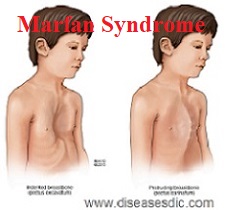Definition
Marfan syndrome is a genetic disorder that affects the body’s connective tissue. Connective tissue holds all the body’s cells, organs and tissue together. It also plays an important role in helping the body grow and develop properly.
Normal and marfan syndrome
Connective tissue is made up of proteins. The protein that plays a role in Marfan syndrome is called fibrillin-1. Marfan syndrome is caused by a defect (or mutation) in the gene that tells the body how to make fibrillin-1. This mutation results in an increase in a protein called transforming growth factor beta, or TGF-β. The increase in TGF-β causes problems in connective tissues throughout the body, which in turn creates the features and medical problems associated with Marfan syndrome and some related disorders.
History
Marfans was first put on record by a French Pediatrician named Antoine Marfan who had a patient that had elongated fingers and toes as well as elongated limbs.
It was dated 1896, since Dr.Marfan was the first to record and therefore discover the characteristics, it took on his name. And has since been called Marfan Syndrome There are over 200 different heritable disorders of connective tissue, including a few which closely resemble Marfan syndrome.
Epidemiology
Prevalence is thought to be similar throughout the world and regardless of sex or ethnicity. The incidence in the European population is estimated to be 3 in 10,000. The incidence in the US population is not accurately known, but is estimated to be 1 in 10,000. The average life expectancy used to be only 32 years but, due to early surgery, it is now approaching that of the general population. Once aortic dissection occurs, survival is considerably reduced to between 50% and 70% at 5 years.
Risk factors
Both males and females can be affected by the condition. Though, having a parent with Marfan syndrome increases your risks of contracting the condition for fifty percent.
Causes of marfan syndrome
- Marfan syndrome is a genetic condition. It is either passed down through families, or it happens when there is a faulty gene in a parent’s sperm or egg.
- Most people with this syndrome inherit it from a parent. A parent with the condition has a 50 percent chance of passing it on to their child, but 25 percent of patients have no parent with the condition.
- The gene that carries Marfan syndrome is called FBN1 encodes a connective protein called Fibrillin-1. This protein helps to give connective tissue its elasticity and strength.
- Without elasticity in the connective tissue, it is difficult for the body to move and flex. Without strength, the connective tissue cannot support the organs and various body parts.
- The defective gene in Marfan stops the body from producing Fibrillin-1.
Symptoms associated with marfan syndrome
Signs and symptoms that may appear in the skeletal system, including bones and teeth, are:
- Long limbs with thin and weak wrists
- Stooped shoulders
- Very long and slender fingers and toes, or both
- Hammer toes
- Sternum, or breastbone, protrudes or caves in
- Extremely flexible joints
- Long and narrow face
- Small bottom jaw that may cause speech disorders
- Overcrowded teeth
- Slim body and taller than average height
- Flat feet
- High palate that may cause speech disorders
- Stretch marks on the skin not due to pregnancy or weight gain
- Pain in the joints, bones and muscles.
Diagnosis and testing
As signs and symptoms can vary widely, diagnosis may be challenging.
The physician will ask about the patient’s family and medical history, and they will listen to the patient’s heart, check the skin for stretch marks, and look at the length and features of the patient’s arms, legs, fingers, and toes. Other conditions with overlapping symptoms, such as Ehlers-Danlos syndrome or Beals syndrome need to be ruled out.
The doctor may refrain from giving a diagnosis in a child until they become a teenager, as signs and symptoms will then be clearer.
Diagnostic tests that may be used include:
- Echocardiogram, to check the state of the heart, valves, and the aorta
-
Electrocardiogram (ECG), to check heart rate and rhythm
- Slit lamp eye exam, to check for dislocated lenses
- Imaging scans, such as CT or MRI, can be used to check the lower back for signs of dural ectasia.
Treatment of marfan syndrome
While there is no cure for Marfan syndrome, treatment focuses on preventing the various complications of the disease. To accomplish this, you’ll need to be checked regularly for signs that the damage caused by the disease is progressing.
In the past, people who had Marfan syndrome rarely lived past 40. With regular monitoring and modern treatment, most people with Marfan syndrome can now expect to live a more normal life span.
Medications
Doctors often prescribe blood pressure lowering drugs to help prevent the aorta from enlarging and to reduce the risk of dissection and rupture. The most commonly used drugs are beta blockers, which cause your heart to beat more slowly and with less force. Losartan (Cozaar), a newer blood pressure medication, also is useful for protecting the aorta.
Prevention of marfan syndrome
- To prevent complications as well as improve the quality of life for patients diagnosed with Marfan’s, taking the proper precautions as well as supplementing with Beta-Blockers is critical
- Cardiac and ophthalmologic abnormalities are common in patients with Marfan’s, and annual echocardiogram and ophthalmologic exams are recommended to prevent fatal complications
- Prescription medications that reduce hemodynamic stress on the aortic wall (Beta Blockers) slow aortic root growth, cause fewer cardiovascular endpoints, and overall improve the survival rate of those diagnosed. They also lower blood pressure, decrease distensibility at the level of the ascending aorta, and reduce the rate of aortic complications

